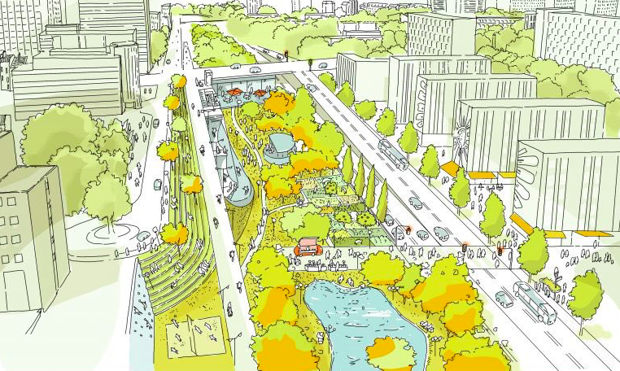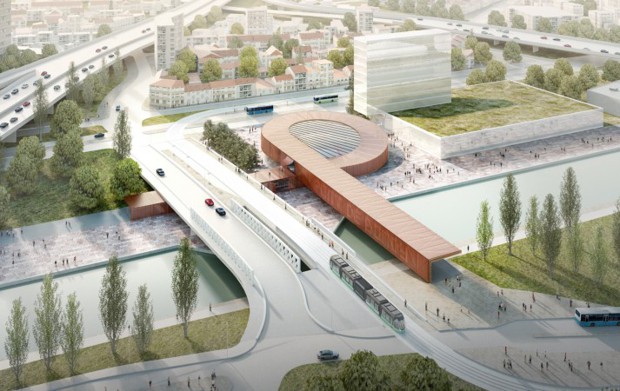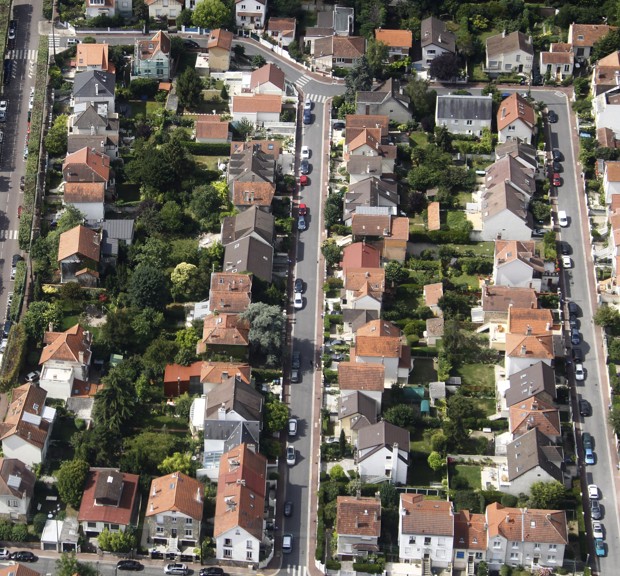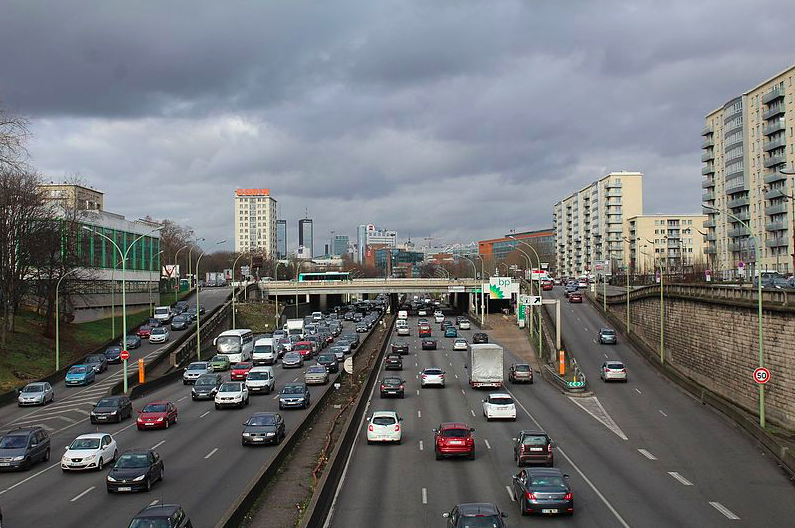 Posted Apr 14, 2017, 4:07 PM
Posted Apr 14, 2017, 4:07 PM
|
 |
Registered User
|
|
Join Date: Aug 2002
Location: Toronto
Posts: 52,200
|
|
|
Fixing a Fractured Paris
Fixing a Fractured Paris
Apr 12, 2017
By FEARGUS O'SULLIVAN
Read More: https://www.citylab.com/transportati...-paris/521967/
Quote:
The suburbs of Paris, home to over 10 million people, are not as universally loved as the central city they surround. The city’s Boulevard Périphérique beltway is a big reason why. Walk towards the orbital road from the Porte de La Chapelle at rush hour and you feel like you’re a witness to a city engaging in an architectural and infrastructural race to the bottom.
- Elegant Haussmann-era buildings along the roadside give way abruptly to modernist boxes. Then the beltway’s tangle of lanes appears, an Amazon of asphalt, exhaust fug, and slow-moving metal. For pedestrians, the route north seems impenetrable, and the patchy provision of sidewalks and noise might rob anyone of the desire to forge on. Such a scene is common in the suburban transition zones of cities in the U.S. and Europe. But in Paris, it comes as a particularly cruel shock to witness the harmonious city end so abruptly.
- The Périphérique, the frontier of Paris Intramuros (or “behind the walls”), has had a vexed role in story of this city since it was completed in 1973. The traffic-choked 35-kilometer ring is one of the busiest in Europe, carrying more than a million vehicles a day. It serves as an essential artery for urban Parisians—and a formidable physical and cultural barrier cleaving those 2.2 million residents from the sprawl beyond. The division is somewhat misleading: There are many architectural and demographic similarities between neighborhoods on either side of the central city’s limit.
- It’s the planning of the metro area around the beltway’s axle that effaces these connections and leads to a fragmentation both of transit and of residents’ identity. This is the new battleground on which Greater Paris needs to combat its domination by cars—both by transforming the beltway and expanding the public transit network beyond. --- The French capital is engaged in an ambitious effort to tame car traffic and bar heavily polluting vehicles in the inner city. Led by charismatic Mayor Anne Hidalgo, who has pledged to reduce the city’s carbon footprint, Paris’s battle to go car-free has captured much international attention.
- The real war on cars will be waged in the banlieues, the sprawling and surprisingly diverse suburbs of Greater Paris. Plans to transform the Boulevard Périphérique and expand mass transit deep into these politically fragmented areas require sign-off from more political bodies and demand a coordinated approach to the entire region’s mobility needs. --- If they work, they could help correct a planning mistake that has led to social segregation and a sense of disconnect between different communities in the city that is unparalleled elsewhere in Europe. If they fail? Expect worse traffic, more angry suburban drivers, and continued political fragmentation.
- Many cities have troubled relationships between urban core and suburb, but Paris’ extreme polarization is in a class of its own. The city’s official boundaries have not enlarged since 1860, meaning that anything beyond Paris’s 19th-century fortifications—the ring upon which the modern beltway was built—does not count as Paris proper. --- One result of this is an ongoing dismissal of the wider city by certain sections of the Parisian elite. Discuss the banlieue with the snobbier sort of Inner Parisian and it comes across as a cultureless wasteland, one whose provinciality is made only more glaring by its proximity to that unmatched pinnacle of human sophistication, Paris itself.
- Like most cities of its size, Greater Paris has its fair share of anonymous-looking districts of single-family homes (though it’s generally far denser than outer London or the suburbs of U.S. cities). It also has great tracts of public housing projects, mainly built from the 1950s through the ‘70s. The huge building program broke up communities and exported urban poverty to a periphery, where it could be more easily disregarded by power. But it’s wildly inaccurate to characterize Paris’s outer rings with one single image. It contains seven very diverse regions.
- The Boulevard Périphérique may divide the city and its suburbs, but it’s also a unifier of sorts: The traffic congestion on the ring—and the haze of accompanying air pollution over both urban and the suburban neighborhoods flanking the road—has managed to create consensus across the political spectrum that something has to change. The sticking point is what. --- This January, France’s right-leaning Republican Party—the largest party currently opposing Paris City Hall’s Socialist-led coalition government and Mayor Anne Hidalgo—proposed a fix that is pharaonic in scale. To reduce noise and pollution and reconnect both sides of the beltway, the Republicans would cover the Périphérique, burying its highway trench under a concrete cap.
- Called the Métropole du Grand Paris (Greater Paris Metropole), this appointed body is supposed to coordinate projects in Greater Paris’s four innermost Départements, plus a few denser districts beyond this boundary. Initially billed as a game changer, the Metropole appears to already be in trouble, suffering from so low a budget that its finance officer warns it may die “while still in the egg.” --- Still, it will be worth following whether the vast and fractious capital can pull this off. Taken together, Paris is pursuing some of the most enlightened and progressive transit policies of any megacity. When it comes to resolving the political fragmentation that simultaneously makes radical action relatively easy in the city’s heart and relatively difficult in the grand patchwork beyond, it may nonetheless still have a long way to go.
.....
|
A pollution warning and speed limit over the ring road in 2014. (Philippe Wojazer/Reuters)
 A beltway gone green: A rendering of the Périphérique transformed into woodsy “urban boulevard.” (Groupe Ecolo Paris)
A beltway gone green: A rendering of the Périphérique transformed into woodsy “urban boulevard.” (Groupe Ecolo Paris)
 A rendering of a proposed Metro station to be built as the Grand Paris Express, an expanded network of suburban lines due to be completed in 2030. (Société du Grand Paris)
A rendering of a proposed Metro station to be built as the Grand Paris Express, an expanded network of suburban lines due to be completed in 2030. (Société du Grand Paris)
 Even suburbs of Paris that are filled with single-family homes with yards tend to be more densely built than the U.S. equivalents
Even suburbs of Paris that are filled with single-family homes with yards tend to be more densely built than the U.S. equivalents
 The Boulevard Périphérique in Southeastern Paris, in a section that would be coverable. (Chabe01/Wikimedia)
The Boulevard Périphérique in Southeastern Paris, in a section that would be coverable. (Chabe01/Wikimedia)

__________________
ASDFGHJK
|



